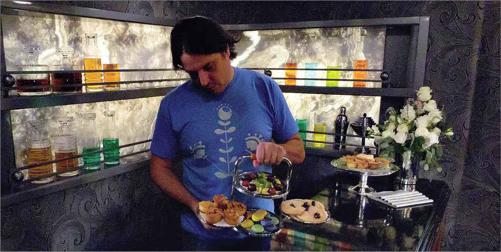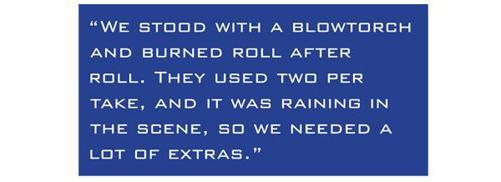The Hunger Games: Official Illustrated Movie Companion (10 page)
Read The Hunger Games: Official Illustrated Movie Companion Online
Authors: Scholastic,Kate Egan
Tags: #Juvenile Nonfiction, #Television & Radio, #Action & Adventure, #Juvenile Fiction, #Performing Arts, #General, #Science Fiction, #Social Issues, #Film, #Survival Stories

Glenn also created the other tributes’ weapons, which had to look lethal but be practical during filming. She says, “Some weapons are made of aluminum. It’s a super-high-quality aluminum that you can actually fight with, blade on blade, metal on metal. Then we figure out if we need any rubber replicas, soft ones you can hit somebody over the head with.”

A close-up of the backpack Katniss grabs at the start of the Games — with a knife protruding.
Careful thought went into designing the parachutes that deliver sponsors’ gifts to the tributes during the Hunger Games. Glenn says, “When I read the book, it said ‘a tiny parachute’ and somehow in my mind it was something very, very small. But when you get the reality that Katniss gets a roll, she gets soup, she gets all these different medicines in the parachute and the container is beneath the parachute . . . it had to expand a lot. We kind of went into this direction that it’s all being controlled anyway by the Capitol, that it didn’t really have to be working but it should appear to be controllable.”
The Capitol’s cruelty even extended to the shocking color of the berries Glenn chose. “We started out thinking, well, maybe we can take blueberries, those really big blueberries that you can find at a certain time of year, and dye them,” she says. “And that didn’t work at all. So we came up with a wild berry that I ordered online, and this particular one that I think is pretty amazing. The juice of it is red, bright red, almost like blood, which we thought was really cool. We went with a frozen one and we have this technique for defrosting them very slowly with paper towels, and we try to keep them as dry as possible so they don’t squish. Still, they were everywhere. Scott Hankins, the costumer, hated us for a few days because of the berry juice that was all over the costumes.”
Gary Ross and Phil Messina hired Jack White, a food stylist, to design and create the food of Panem. “When we were at District Twelve, there were a few scenes with Katniss and her mom where her mom is cooking. The beans and the greens that we had for them to eat looked almost rotten. The thought was not to bring in beautiful food, but to pick stuff that looked almost like it was about to decompose.”

Top: Phil Messina, production designer, arranges the food in the train car.
Below: Examples of Capitol food.

In the Capitol, though, he worked with fresh food and bright colors. “Blues, oranges, greens . . . but not any pastels, not any earth tones. Nothing brown.” White’s job was not to make food that the actors would eat while filming, but rather to make food that seemed right for the strange and luxurious world of the Capitol. “I have to make things that could last twelve hours on the set. Showpieces, really. Israeli couscous — you can make that any color you want. And quail eggs. Two seconds in a colored water and they come out looking beautiful.”
Food plays an unusually important role in
The Hunger Games
, since it’s one way the Capitol exerts its power over the districts. People feast in the Capitol while they starve in the districts, and over the course of the book Katniss’s experiences are reflected in the food she eats. “Before the Games, when Katniss is at home, she’s hungry,” says Jack White. “She’s having to hunt for food, struggling to find something to eat. Then, as she’s on her way to the Games, she experiences — for the first time — an abundance of food. It’s probably the first time in her life that she’s seen that much, and it’s all available to her. Then, once she arrives in the Capitol, it’s completely over the top and she’s not even sure what it is that she’s getting to see.”
As Collins lavished attention on the food in her book, Ross lavished attention on the smallest food details in the film, working with Jack White to bring his vision to life.

Creating the bread of District 11, for instance, was a long process. White remembers, “In the movie, Katniss receives a gift from District Eleven — the roll floats down to her in the arena. The director was very specific in what he wanted that roll to look like. So I think we made about fifteen or twenty different kinds of rolls. They all had to be a specific size and weight to make sure they would fit in the container. It ended up being a half-wheat, half-white flour, so that gave it a nice color. We were stenciling the number
11
on, until the director asked us if we could try to burn it in. So then that involved another company that did the brands for us. We had to find the right font for that. Then they decided they’d like to see a ring around the number, so that was another step. I had the eleven burned right into the center of the roll, but that looked too perfect — it needed to seem more like an afterthought, so the brand ended up in the right-hand corner. And then I had to make seventy-five of those, because you can’t just have one.”
Likewise, a great deal of thought and effort went into creating the bread that Peeta throws to Katniss when she’s on the brink of starvation. White says, “We went to a bakery in Asheville and we got several samples of different sizes of bread to show Gary, and Gary picked the one he liked. In the scene, Peeta throws burned bread from his family’s bakery to Katniss. So we stood with a blowtorch and burned roll after roll. They used two per take, and it was raining in the scene, so we needed a lot of extras.”
White worked closely with other members of the design team to make sure that the food created a flawless look together with the sets and the props. “Some of the food choices depend on what the set decorator, Larry Dias, does. For instance I need to know what the plates look like before I know what sort of food I can put on them. On one of my first jobs, they ordered lobster for the scenes, and the lobster was three times bigger than the plate.”
And when he cooked for the filming, he always cooked extra, in case something went wrong. “The suckling pig was cooked with something in its mouth to keep it open. After it was cooked, we replaced that with an apple. We had to make three pigs because if something happened while they were shooting the arrow into the apple, we’d be up the creek. Every take, we put a new apple in there.”
The visual sense of the movie began with the locations and props, but soon extended to the characters at the heart of the story.



N
ow that the overall look of the movie was in place, it was time to design the look of the characters. Costume designer Judianna Makovsky spoke extensively with Gary Ross early on about a general look for the characters in
The Hunger Games
. “Gary and I agreed that it had to be a recognizable world, not a foreign, futuristic world,” Makovsky says. “People needed to be able to relate to it.” She smiles and adds, “But it was really fun for us, too. We could do outrageous things that we don’t usually get to do in a movie.”

